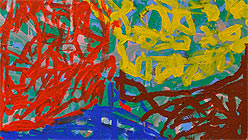Jeremy Burleson builds lyrical dinner-plate sized structures of tightly rolled paper. The paper tubes are bent and held together with different colors of masking tapes. The pieces dangle from the ceiling on clear threads. Gallery director Brian Stechschulte, refers to the pieces as lanterns. Stechschulte also relates the creation myth behind them. Burleson was at Costco and knocked over a lamp, shattering it all over the aisle, probably giving Jeremy a little bit of shame, but a lot of pleasure.
Last week, Jeremy asked a reporter for the San Francisco Chronicle if he wanted to throw one of Jeremy’s pieces to the ground. After a moment of hesitation from the writer, Jeremy showed him how to do it. It’s not hard to connect the dots. Burleson’s intention is to use art to return to a seminal experience in his development as a person, just like Barney.
Burleson and Weiss both have disabilities. Both are artists who create their work at the studio program in Richmond’s National Institute of Art & Disabilities (NIAD). And here is the kicker, for the most part neither artist is given the chance to show their work in the same light as mine (I’m a painter). Most galleries, and many museums, do not show work by artists with disabilities unless they have been accepted into the artworld before they were disabled (think Chuck Close and Willem de Kooning). Sure, there are art fairs, galleries and museums that deal exclusively in work from artists with disabilities, but few contemporary art venues will show art from both kinds of makers under one roof, at the same time.
When I started visiting NIAD three years ago, the first thing I noticed was that NIAD is a studio program; it’s not about art therapy. It is a place where working artists help artists with disabilities find their voice and follow their obsessions. Not everything that comes out of NIAD is a masterpiece, but some of it is. For painter Mia Brown, who cannot use her arms, NIAD figured out how to attach a paint brush to a stick and rig it to a helmet. Brown, painting with her head, creates complex fields of color that house ornate structures, not unlike her counterpart in the contemporary painting world, Terry Winters. And they are magnificent.
The similarities between the intentions of NIAD’s artists and my artist friends were striking enough that I began to realize we needed to be shown together, something that was not happening at the time. There were no galleries in the area including artists with disabilities in shows with artists who may not have a diagnosis extreme enough to qualify them as “other.” So I began organizing a series of ground-breaking exhibitions called Life Of The World To Come. Obviously, the title refers to the day when all of our art is seen in the same light (and it is the title to my favorite Mountain Goats record). Twist and Crawl is the first of these exhibitions.
Stevie Wonder is blind. Mel Tillis has a stutter. Joey Ramone had OCD. Roky Erickson is a paranoid schizophrenic. Daniel Johnston is bipolar. But we don’t listen to their songs on a special radio station set aside for musicians with disabilities. I doubt we even think about their disabilities when we enjoy their music. We never question their intention to create art. And we don’t flip the dial to hear their songs.
Twist and Crawl was put together so we can all be played on the same station.
Twist and Crawl is on view January 18 through March 16, 2011 at NIAD’s gallery, 551 23rd Street in Richmond. The opening reception is Saturday, January 22 from 2pm to 5pm. The exhibition features work from James Aarons, Chris Ashley, Elaine Bradford, Mia Brown, Timothy Buckwalter, Jeremy Burleson. Sharon Butler, Willie Harris, Cliff Hengst, Shirley How, Lacee King, Dorrie Reid, Katy Stone, Danny Thach and John Zurier. For more information visit niadart.org.


